I will continue living the writing life, even if it doesn’t lead to fame or fortune

If you want people to pay attention to your ideas these days, you really need to put things in video format. Ideally one that less than 30 seconds long and includes something funny or unexpected. It helps with the algorithm.
At the end of last year, The Economist published an article entitled Are adults forgetting how to read? which concluded “You do not need a first-rate mind to sense trouble ahead.” Stowe Boyd riffs on this and, like me, resists the temptation to ‘pivot’ to video with every fibre of his being.
The decline of literacy and the eclipse of reading, combined with algorithmic feeds breaking the ‘traditional’ follower model of the blogosphere and pre-TikTok social media, may be the death of newsletters, and ultimately, writing.
[…]
In the near term, while the streams of video and AI slop seemingly are clogging every available orifice in the body public, I will continue living the writing life, even if it doesn’t lead to fame or fortune.
Source: workfutures.io
Image: Thomas Franke
Most decisions are like hats
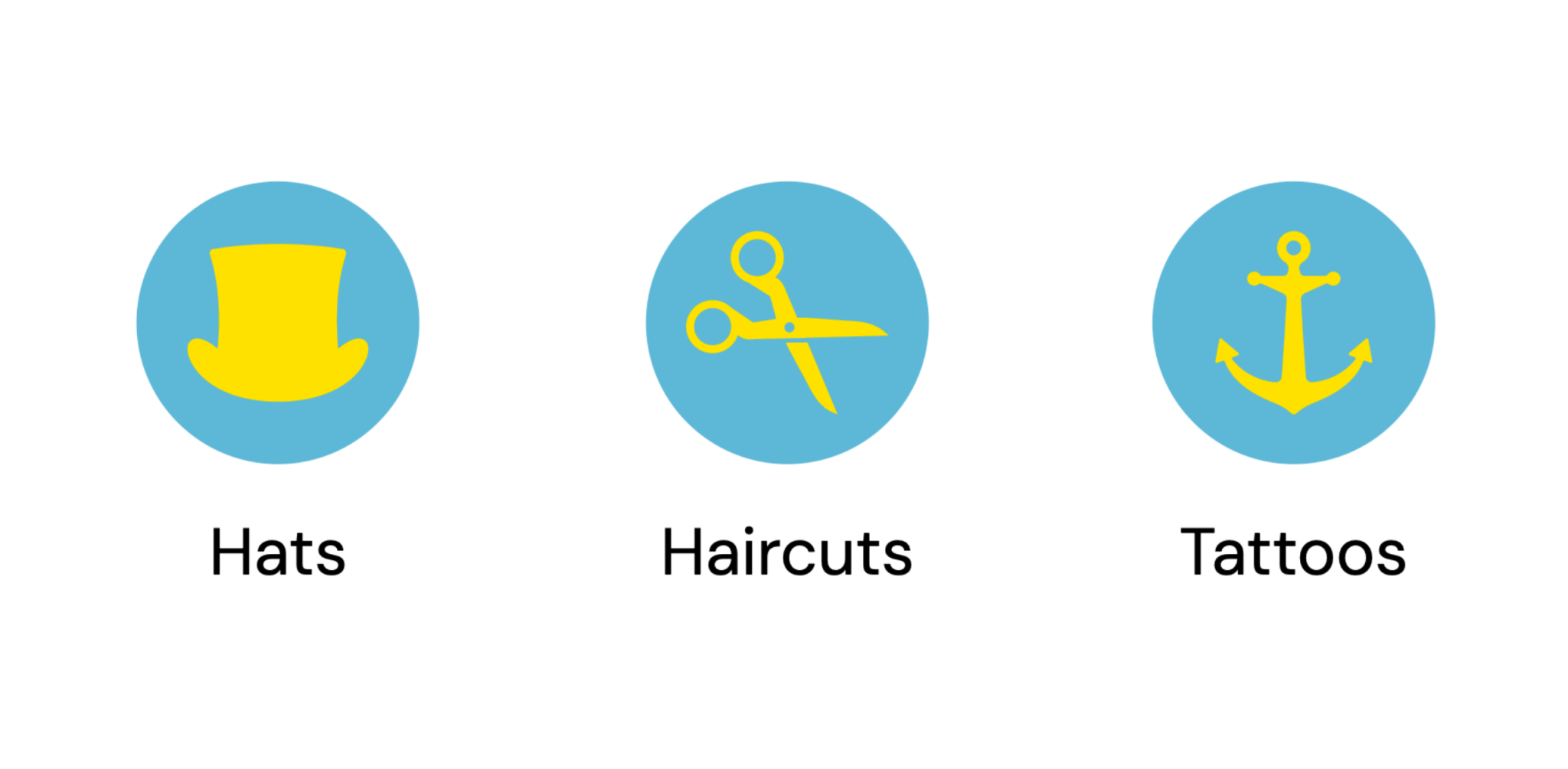
I like things that come in threes, and this in particular seems like a useful heuristic for helping categorise a change process. Emily Webber riffs on an original idea by James Clear: is this like a hat, a haircut, or a tattoo?
The language that I tend to use with clients around this, informed by Sociocracy is whether a proposal or idea is “good enough for now, and safe enough to try.” Going forward, I think I might couple that with these metaphors.
Most decisions are like hats. Try one and if you don’t like it, put it back and try another. The cost of a mistake is low; the decision is made quickly and can be easily reversed. Teams should be able to make these on their own and share the results fairly quickly.
[…]
Some decisions are like haircuts. You can fix a bad one, but reversing it can take some effort, and you might need to live with it for a while.
[…]
A few decisions are like tattoos. Once you make them, you have to live with them. Reversing them would be very expensive and painful, and not always possible.
Source & image: Emily Webber
Referencing an imaginary 'social contract' that is violated by AI

I just wanted to express full agreement and solidarity with Stephen Downes' view of how and why we should put things on the internet (emphasis added).
“The open web is under attack by AI bots that steal web publishers' content,” writes Nate Hake on some travel blog site. Normally I wouldn’t bother, but it’s referenced by Paul Prinsloo and is yet another article referencing an imaginary ‘social contract’ that is violated by AI. “In the past,” writes Hake, “search engines and platforms sent real human users to websites. Today, they increasingly send AI bots instead.” But search engine traffic matters only if you run advertisements on your site; for people like me, the traffic sent by Google, say, is just traffic I have to pay for. That’s why I’m happy to syndicate my site on RSS and social media; it’s good for me if people read my stuff elsewhere. So I don’t mind if AI bots crawl my site (provided they don’t amount to a DOS attack) and my only real desire would be to have AI credit me with an idea if it happens to originate with me. But even this isn’t part of any ‘social contract’. Sure, if you don’t want AI to crawl your site, block it (or turn over control of the internet to Cloudflare, your call). To me, sharing the ideas is what counts, and sharing is not transactional and not based on any social contract.
Source: Downes.ca
Image: Gaku Suyama
You'd have to be naive to be surprised
‘Dead internet theory’ is a conspiracy theory which, like most conspiracy theories, is based on a vibe and a kernel of truth rather than anything resembles actual fact. It asserts that “since around 2016 the Internet has consisted mainly of bot activity and automatically generated content manipulated by algorithmic curation, as part of a coordinated and intentional effort to control the population and minimize organic human activity.”
When you see videos like this one, however, you realise that — especially on some social networks — there is a lot of algorithmic manipulation. However, it’s more to do with influence (commercial, political) than “controlling the population” and relies, like most things, on economic incentives to act in a particular way.
Source: Reddit
Some thoughts on the Digital Badging Commission's report
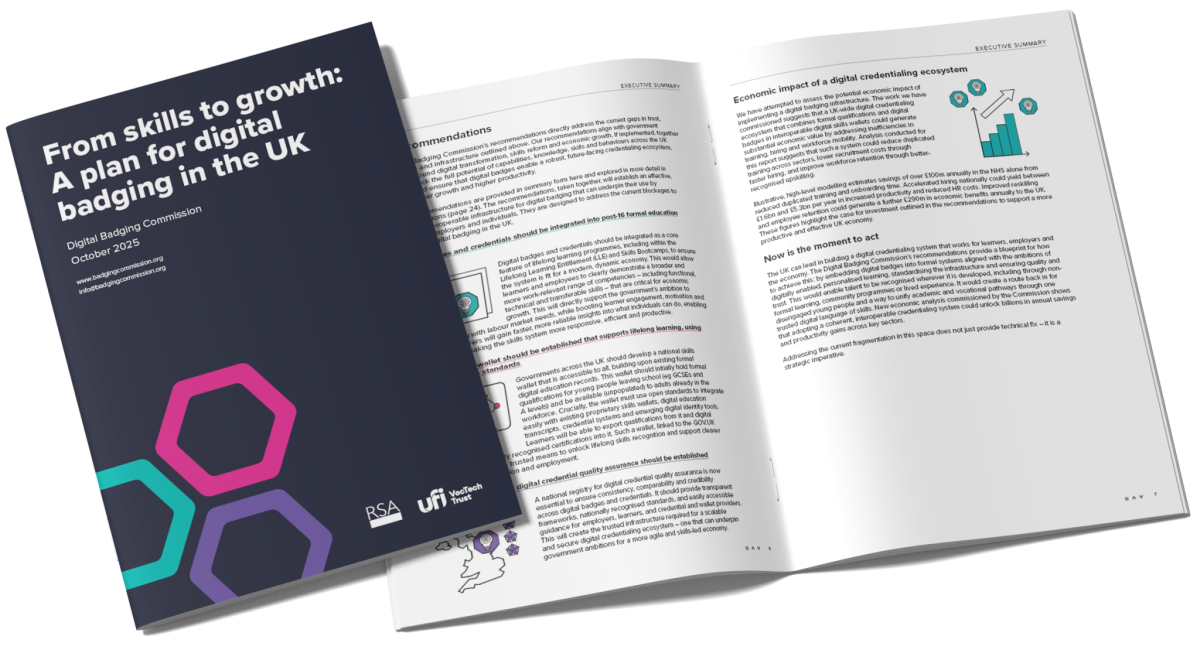
I was going to spend some time writing a detailed blog post about a new report from the Digital Badging Commission entitled From skills to growth: A plan for digital badging in the UK. But instead of damning it with faint praise, I’ve decided that all I’ve got to say fits into some basic traffic light feedback:
🟢 It’s good that the report stresses the importance of open standards and interoperability, and suggests that various official bodies explore using badges.
🟡 It seems there’s a fundamental conflation of quality assurance and technical validation (the word ‘registry’ suggests the latter but explicitly used in the context of the former). Also, using terminology (CLR, LER) which is only really used in the US really muddies the water for the reader.
🔴 Despite language of empowerment and recognition towards the start of the report, the third recommendation merely cements the status quo of ‘vetted providers’ being the providers of ‘skills.’
I got involved in Open Badges 14 years ago because of the standard’s revolutionary, decentralised potential. The various iterations and improvements have already led to massive innovation across the world with hundreds of millions of badges being issued each year. The role of official bodies is therefore coordination not imposition.
TL;DR: I think the first two recommendations are… fine. It’s the third one which I think is problematic.
The Digital Badging Commission’s recommendations directly address the current gaps in trust, coordination and infrastructure outlined above. Our recommendations align with government ambitions around digital transformation, skills reform and economic growth. If implemented, together they will unlock the full potential of capabilities, knowledge, skills and behaviours across the UK workforce and ensure that digital badges enable a robust, future-facing credentialing ecosystem, driving stronger growth and higher productivity.
[…]
1. Digital badges and credentials should be integrated into post-16 formal education and training Digital badges and credentials should be integrated as a core feature of lifelong learning programmes, including within the Lifelong Learning Entitlement (LLE) and Skills Bootcamps, to ensure the system is fit for a modern, dynamic economy. This would allow learners and employees to clearly demonstrate a broader and more work-relevant range of competencies – including functional, technical and transferable skills – that are critical for economic growth. This will directly support the government’s ambition to better align learning with labour market needs, while boosting learner engagement, motivation and progression. Employers will gain faster, more reliable insights into what individuals can do, enabling smarter hiring and making the skills system more responsive, efficient and productive.
2. A national skills wallet should be established that supports lifelong learning, using interoperable open standards Governments across the UK should develop a national skills wallet that is accessible to all, building upon existing formal digital education records. This wallet should initially hold formal qualifications for young people leaving school (eg GCSEs and A levels) and be available (unpopulated) to adults already in the workforce. Crucially, the wallet must use open standards to integrate easily with existing proprietary skills wallets, digital education transcripts, credential systems and emerging digital identity tools. Learners will be able to export qualifications from it and digital badges and professionally recognised certifications into it. Such a wallet, linked to the GOV.UK One Login, will provide a trusted means to unlock lifelong skills recognition and support clearer pathways through education and employment.
3. A national registry for digital credential quality assurance should be established A national registry for digital credential quality assurance is now essential to ensure consistency, comparability and credibility across digital badges and credentials. It should provide transparent frameworks, nationally recognised standards, and easily accessible guidance for employers, learners, and credential and wallet providers. This will create the trusted infrastructure required for a scalable and secure digital credentialing ecosystem – one that can underpin government ambitions for a more agile and skills-led economy.
Source: Digital Badging Commission
But what a time to be alive, to be living though all of this, inside the churn.
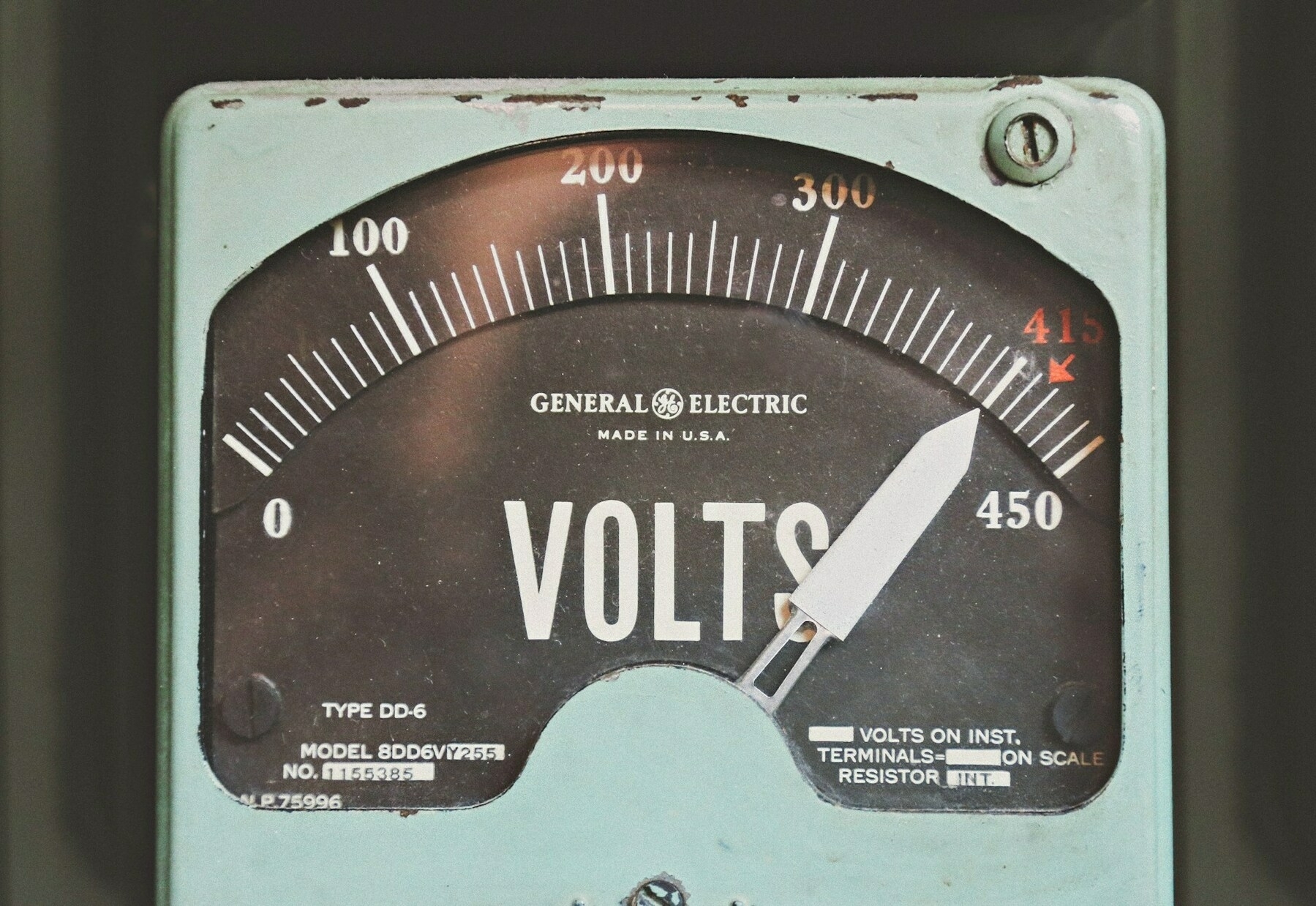
I can’t say that I have the same response to the ‘voltage of the age’ as Jay does, but I recognise the reference to Tennyson. My anxiety, which I’m also dealing with, makes me want to withdraw and let other people figure it out. There’s only so much storm my small boat can take.
Every single day right now it seems like I’m waking up in the morning to some new piece of bullshit. Some new AI thing, some new crypto thing happening, some new insane crypto AND AI thing, politics is mad, war is happening and only going to get worse every where, a genocide is playing out in full view of the world, biosphere collapse, the news of AMOK collapse risk, there is no end to the horrors.
The sea is so very big and my boat is so very small.
But what a time to be alive, to be living though all of this, inside the churn.
It’s not that I want any of this to happen. It’s just can help but watch. As I said to someone the other day, my body keeps registering the ‘voltage of the age‘. Translating my former feelings of anxiety into something like exhilaration from the acceleration around me.
[…]
The only response to this whole unfolding crisis is to stay fully awake inside the gyre. To resist being programmed into unawareness even as the slop machine churns out it’s dreams. We may not be able to slow the velocity of the ongoing circle, but we can at least pay attention to the circle itself, not it’s products. We can name the feeling as ‘voltage of the age’, and refuse to forget that we are in fact still here, alive, and can care for one another, as it’s all happening right now.
Source: thejaymo
Image: Thomas Kelley
It is the opposite of a memory palace. Not at all a wunderkammer.
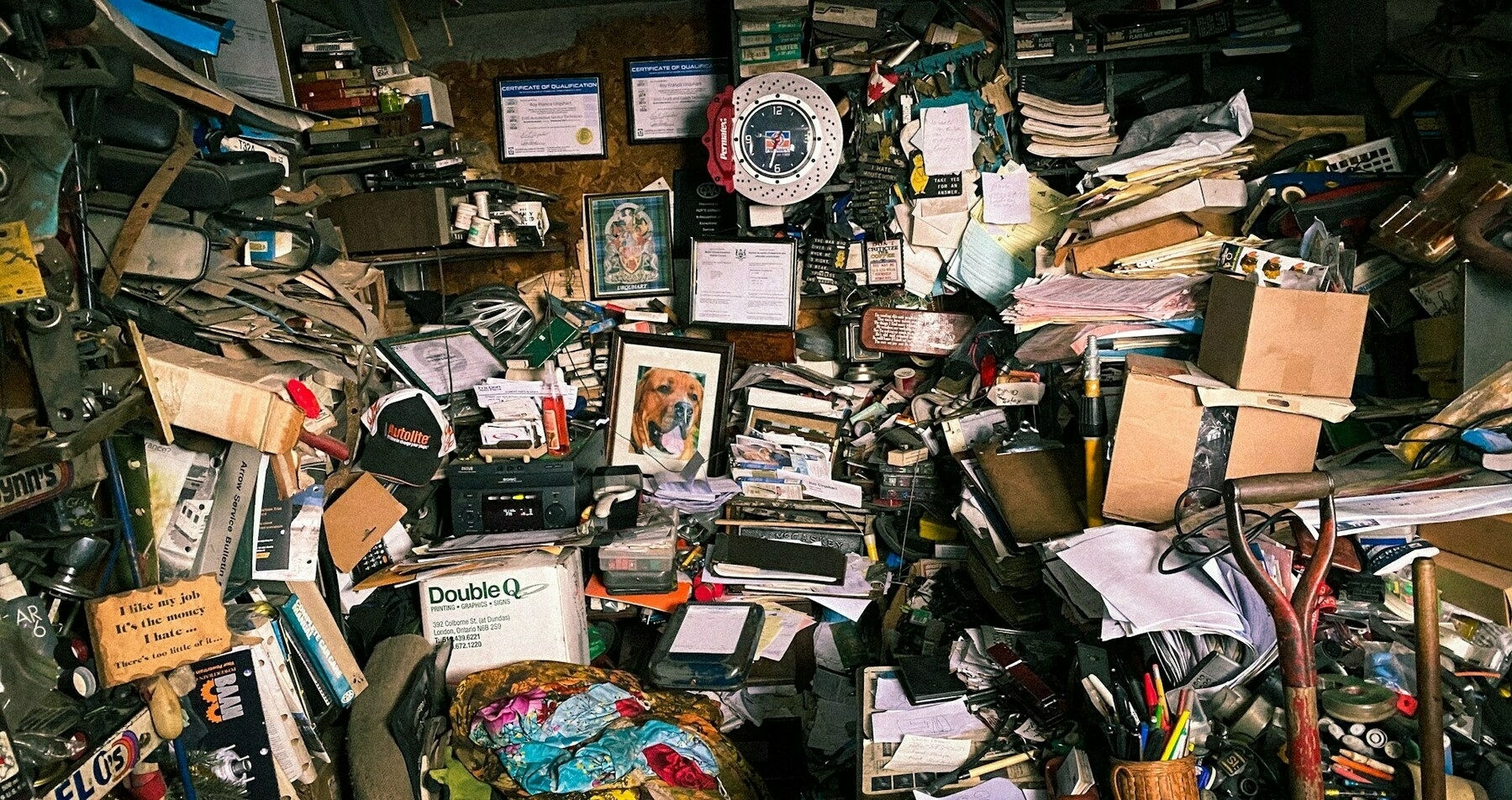
Everyone works differently, which becomes evident when you observe writers' favourite writing spots. In this post, the author Warren Ellis talks about his idea space which doesn’t have to be ordered, tagged, and categorised.
One of the reasons I put so much stuff on the web rather than into notebooks or files that only I can access is that it’s often easier to search a keyword plus my name to remind myself what I’ve said over the years.
Also, to me at least, serendipity is more important than categorising everything perfectly. I know what I’m like: I’d end up re-categorising things endlessly…
I’m assembling a little idea space I want to do some work in. For other people, I suppose this is like moodboarding – and I always encourage artists to show me their moodboards for the areas they’re currently interested in. For me, it’s a bit more messy and cobwebby. It’s what I want to talk about and how I want to talk about it. There’s no method, protocol, routine or discipline beyond making myself sit with an open notebook and thinking into it. Which also involves searching my memory. Sorting through the calamitous disarray of drawers and cupboards in my head for bits of films and half-remembered lines and barely recalled posters and graphics. It is the opposite of a memory palace. Not at all a wunderkammer. Anyone who’s seen my actual physical office will get the idea. Weirdly, I discover things better when they’re all over the place. And I accumulate a hundred new things into the piles every day, and covet more.
Source: Warren Ellis
Image: Nechirwan Kavian
A design philosophy that treats users as citizens of a shared digital system rather than cattle
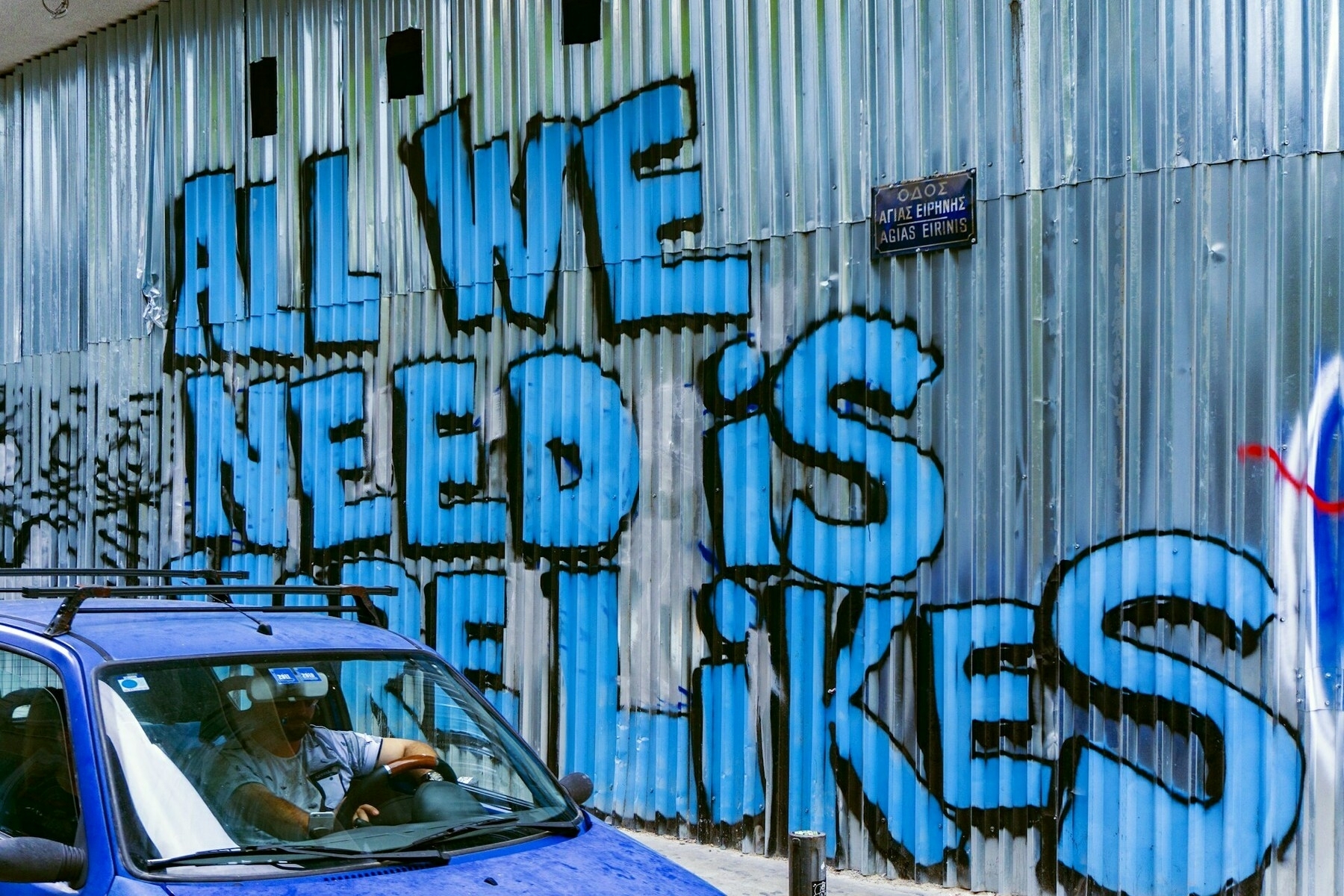
I’m taking this week off social networks, which for me means Mastodon, Bluesky, and LinkedIn. I’ve realised it really doesn’t help with my anxiety to be bombarded with endless stuff about AI, war, and spicy takes about the latest online drama.
As this article by James O’Sullivan in NOEMA discusses, the dream of mass social media has ended and we now live in its ruins. Engagement is down, yet most people get their “news” from social media. We live in a very strange world where people realise what they consume isn’t reliable but do so anyway.
Coincidentally, I’d spent some time reacquainting myself with Are.na earlier today before reading this post. It influenced my design of MoodleNet, the digital commons where communities curated collections of resources. What I like about Are.na is that it’s ‘social’ while still being appropriately weird and not focused on influence.
See also Bonfire from the remnants of the MoodleNet team and which, unlike Are.na, is part of the Fediverse. We should decide who we want to be first, and then choose our tools and networks based on that choice, rather than the other way around.
The problem is not just the rise of fake material, but the collapse of context and the acceptance that truth no longer matters as long as our cravings for colors and noise are satisfied. Contemporary social media content is more often rootless, detached from cultural memory, interpersonal exchange or shared conversation. It arrives fully formed, optimized for attention rather than meaning, producing a kind of semantic sludge, posts that look like language yet say almost nothing.
[…]
While content proliferates, engagement is evaporating. Average interaction rates across major platforms are declining fast: Facebook and X posts now scrape an average 0.15% engagement, while Instagram has dropped 24% year-on-year. Even TikTok has begun to plateau. People aren’t connecting or conversing on social media like they used to; they’re just wading through slop, that is, low-effort, low-quality content produced at scale, often with AI, for engagement.
And much of it is slop: Less than half of American adults now rate the information they see on social media as “mostly reliable”— down from roughly two-thirds in the mid-2010s. Young adults register the steepest collapse, which is unsurprising; as digital natives, they better understand that the content they scroll upon wasn’t necessarily produced by humans. And yet, they continue to scroll.
The timeline is no longer a source of information or social presence, but more of a mood-regulation device, endlessly replenishing itself with just enough novelty to suppress the anxiety of stopping. Scrolling has become a form of ambient dissociation, half-conscious, half-compulsive, closer to scratching an itch than seeking anything in particular. People know the feed is fake, they just don’t care.
[…]
These networks once promised a single interface for the whole of online life: Facebook as social hub, Twitter as news‑wire, YouTube as broadcaster, Instagram as photo album, TikTok as distraction engine. Growth appeared inexorable. But now, the model is splintering, and users are drifting toward smaller, slower, more private spaces, like group chats, Discord servers and federated microblogs — a billion little gardens.
[…]
But the old practices are still evident: Substack is full of personal brands announcing their journeys, Discord servers host influencers disguised as community leaders and Patreon bios promise exclusive access that is often just recycled content. Still, something has shifted. These are not mass arenas; they are clubs — opt-in spaces with boundaries, where people remember who you are. And they are often paywalled, or at least heavily moderated, which at the very least keeps the bots out. What’s being sold is less a product than a sense of proximity, and while the economics may be similar, the affective atmosphere is different, smaller, slower, more reciprocal. In these spaces, creators don’t chase virality; they cultivate trust.
[…]
This isn’t about making platforms needlessly cumbersome but about distinguishing between helpful constraints and extractive ones. Consider Are.na, a non-profit, ad-free creative platform founded in 2014 for collecting and connecting ideas that feels like the anti-Pinterest: There’s no algorithmic feed or engagement metrics, no trending tab to fall into and no infinite scroll. The pace is glacial by social media standards. Connections between ideas must be made manually, and thus, thoughtfully — there are no algorithmic suggestions or ranked content.
[…]
[T]here is a possible future where a user, upon opening an app, is asked how they would like to see the world on a given day. They might choose the serendipity engine for unexpected connections, the focus filter for deep reads or the local lens for community news. This is technically very achievable — the data would be the same; the algorithms would just need to be slightly tweaked — but it would require a design philosophy that treats users as citizens of a shared digital system rather than cattle. While this is possible, it can feel like a pipe dream.
Source: NOEMA
Image: Daria Nepriakhina
Ratcheting up the risks of a possible AI bubble by inflating the market and binding the fates of numerous companies together
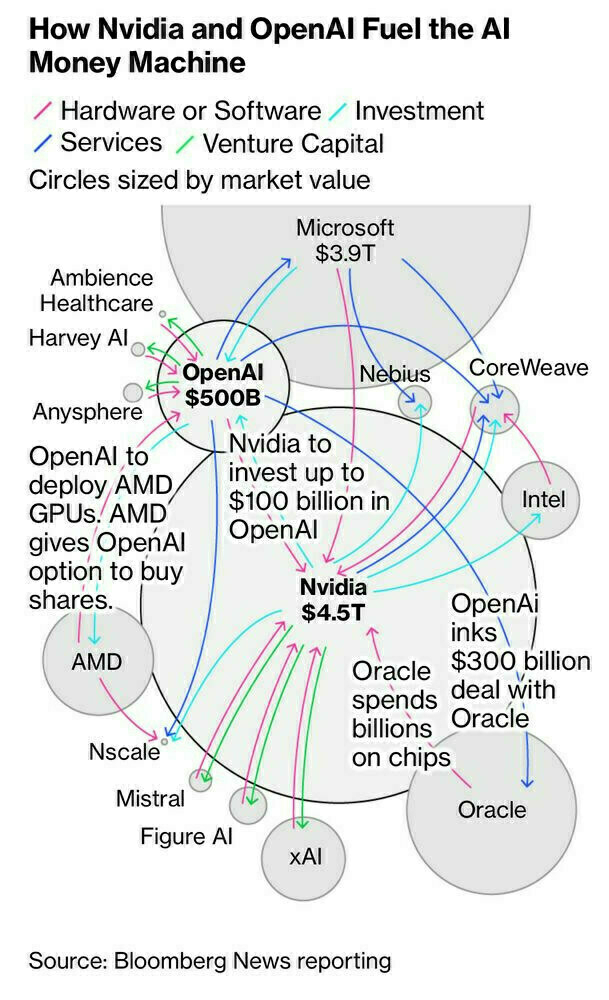
This diagram has been shared multiple times in the networks of which I’m part, but I’m mainly including it here as a form of bookmarking for future reference. There have been plenty of articles about AI being a ‘bubble’ this week but as Stowe Boyd points out, “even if there is an AI bust in the near-term, it doesn’t mean there won’t be an AI-dominated economy in the future.”
Never before has so much money been spent so rapidly on a technology that, for all its potential, remains largely unproven as an avenue for profit-making. And often, these investments can be traced back to two leading firms: Nvidia and OpenAI. The recent wave of deals and partnerships involving the two are escalating concerns that an increasingly complex and interconnected web of business transactions is artificially propping up the trillion-dollar AI boom. At stake is virtually every corner of the economy, with the hype and buildout of AI infrastructure rippling across markets, from debt and equity to real estate and energy.
The companies, which ignited an AI investment frenzy three years ago, have been instrumental in keeping it going by inking large and sometimes overlapping partnerships with cloud providers, AI developers and other startups in the sector. In the process, they’re now seen as playing a key role in ratcheting up the risks of a possible AI bubble by inflating the market and binding the fates of numerous companies together. OpenAI alone has now struck AI computing deals with Nvidia, AMD and Oracle Corp. that altogether could easily top $1 trillion. Meanwhile, the AI startup is burning through cash and doesn’t expect to be cash-flow positive until near the end of the decade.
Source & image: Bloomberg
Government IDs, are becoming hacker targets with bad actors aware of the high volume of sensitive data

I spent a lot of Friday working through the ramifications of the UK’s Online Safety Act (OSA) for a client. Although I’m sure the OSA wasn’t designed as such, it’s likely to have a chilling effect on free speech as it places so much of a burden on those running community platforms.
As a result, I should imagine that, instead of using Open Source software and creating a bespoke environment, many groups will end up using platforms provided by larger tech companies. This means their users will be subject to whatever age verification process that the tech company has chosen.
In the case of Discord, which is used by many communities, that means biometric details. It’s pretty bad that a hack has meant the leak of these details. Of course, the best thing is not to store these centrally in the first place.
Critics will assume that this is another reason not to push ahead with digital ID. But, actually, the opposite is true. Legislation such as the OSA means that providers have to implement solutions that store copies of things like passport details. With government-provided digital IDs, it’s actually the identifier that is held centrally: the biometrics stay on your device.
Some countries, including the UK, require social media and messaging providers to carry out age checks to ensure child safety. In the UK this has been the case since July under the Online Safety Act. Cybersecurity experts have warned of a risk that some providers of such checks, which can require government IDs, are becoming hacker targets with bad actors aware of the high volume of sensitive data.
“Recently, we discovered an incident where an unauthorised party compromised one of Discord’s third-party customer service providers,” Discord said in a statement. “The unauthorised party then gained access to information from a limited number of users who had contacted Discord through our customer support and/or trust and safety teams … Of the accounts impacted globally, we have identified approximately 70,000 users that may have had government ID photos exposed, which our vendor used to review age-related appeals.”
Source: The Guardian
Image: Evgeniy Alyoshin
A Snickers and a power shower would blow Henry VIII’s mind

From jet lag to gene editing, this article has a list of things that shows how different humanity is now from previous generations. We know all of this, but when you put it all in one place it’s pretty eye-opening.
When things seem so negative in the world, it’s worth reminding ourselves that we’ve actually never had it so good.
If the history of humanity were condensed into a single 24-hour day, this is roughly what it would look like:
- The Hunter-Gatherer Age—23 hours and 3 minutes
- The Agrarian Age—55 minutes and 32 seconds
- The Industrial Age—1 minute and 17 seconds
- The Information Age—11 seconds
More than half of the world’s population is under the age of 30, meaning that the majority of humans alive today have only lived in those 11 seconds—an era that is, without question, the weirdest period in human history.
Consider, for example, this observation, conveyed by the Dutch sociologist Ruut Veenhoven: “the average citizen lives more comfortably now than kings did a few centuries ago.”
A Snickers and a power shower would blow Henry VIII’s mind.
This morning, I woke up in a supremely comfortable bed, knowing there would be no deadly predators or pests to eat or infect me. With cheap soaps and pristine, hot water, I became cleaner in five minutes than was possible for any human—no matter how wealthy—in the past.
Source: The Garden of Forking Paths
Image: Loris Boulinguez
The valorization of “agency” is also an adaptation to a crumbling social system which no longer offers support or meaning to the individual

This is a very well-written and insightful piece from James Vincent in The Baffler. It’s about agency and AI, with the punchline being an extension of something I posted about earlier this year in We’re all below the AI line except for a very very very small group of wealthy white men.
The reminder that ‘you can just do things’ feels empowering and emancipatory, foregrounding our ability to make change in the world. However, what it leaves out is the systemic issues that plague our world and—in a world increasingly mediated by AI—feels somewhat like a taunt by the haves to the have-nots.
Some people do things, others have things done to them. The important thing to remember is that sometimes your ability to act in the world is constrained by things beyond your ability to change.
On a personal level the principle that you can just do things is, in my opinion, broadly true, admirable, and helpful. It’s a reminder that we’re frequently constrained as much by our own imagination than by external factors, and that action—any action—is often preferable to overthinking and paralysis. You could try to trace the history of this idea, but it’s so broad that it resists meaningful narrative. It’s simply a truism of the human condition that has been framed and reframed by successive generations. You can find echoes everywhere from the aphorisms of Epictetus (“Now is the time to get serious about living your ideals. . . . How long can you afford to put off who you really want to be?”) to the essays of Ralph Waldo Emerson (“The power which resides in him is new in nature, and none but he knows what that is which he can do, nor does he know until he has tried.”). But while in its simplest form the notion of just doing things has no set ideology (apart from a vague sense of libertarianism), its current vogue exemplifies specific political and social trends. More specifically, it speaks to a pessimism about society’s capacity to improve itself; throwing responsibility back on the individual, like the “entrepreneur of the self” described by Michel Foucault.
[…]
More broadly, the valorization of “agency” is also an adaptation to a crumbling social system which no longer offers support or meaning to the individual. This usage is a rebranding of established neoliberal thought: if you are struggling in life, if you’re anxious or lonely or can’t afford the rent, it’s because you are simply not being agentic, you’re not trying enough. In this framing, social challenges become the responsibility of the individual, and collective responses are framed as a form of moral infirmity. (“The fundamental weakness of western civilization is empathy,” as Musk put it.) The only real change is that the stakes have increased. Instead of pulling yourself up by your bootstraps, walking round local businesses with a pile of résumés till you get a job, you should bootstrap your own billion-dollar business. After all, the tools are all there, so why not show a little bit of agency?
The irony is that while political and technological developments are encouraging people to “just do things,” these same developments are making human agency harder to exercise, particularly with regard to AI. In the cultural realm, the replacement of artistic choice by AI tools means removing a level of intent and decision-making. A filmmaker might, in the past, have carefully considered how to light, frame, and block a certain shot; in the future, AI will make these decisions instead, drawing its decisions from a weighted average of its training data. In online spaces, arguments are now ceded to AI adjudicators. On X, the cry of “Grok, is this true?” is slowly taking over from human debate (even though it’s clear that one highly agentic individual, Elon Musk, has his finger on the scales when it comes to Grok’s opinions). Even worse, people trying to make a specific point don’t even bother to formulate the argument themselves. They just get machines to justify their thoughts for them.
[…]
Everywhere we look, the world is ceding control to automatic systems that cannot be reasoned with like humans and whose decisions are often inscrutable, interrogated only after the damage has been done. The delegation of such responsibility is often embraced in the name of efficiency or neutrality, but can also be manipulated by those in power while disenfranchising the masses. This is, perhaps, the real reason that so many people are keen to tell one another that “you can just do things.” It’s a reaction to a world in which, instead, things are just done to us.
Source: The Baffler
Image: Daniel K Cheung
Microcast #108 — Skills Taxonomies
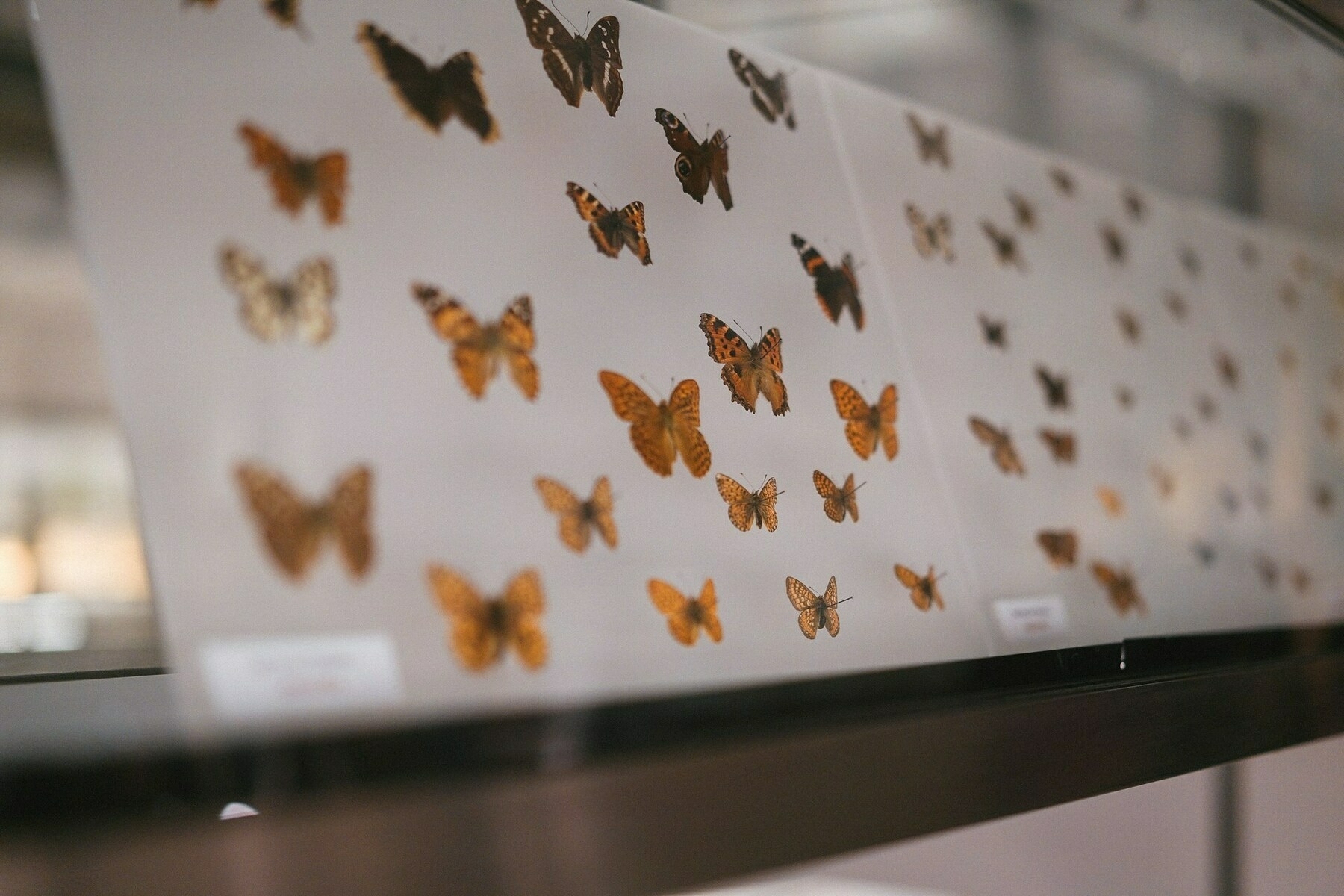
Some thoughts on skills taxonomies, skills ontologies, and learning pathways in an ever-changing world. Although I didn’t mention them in the microcast, the following posts are relevant.
Show notes
- Building Trust and Rigor in Microcredentials: Synthesizing Standards, Taxonomy, and Frameworks (EDUCAUSE)
- What Constitutes ‘Rigour’ in Our 21st-Century Educational Systems? (Connected Learning Alliance)
The alternative to depression is not happiness, but feeling whatever is there, a kind of truthful emotional spontaneity and freedom
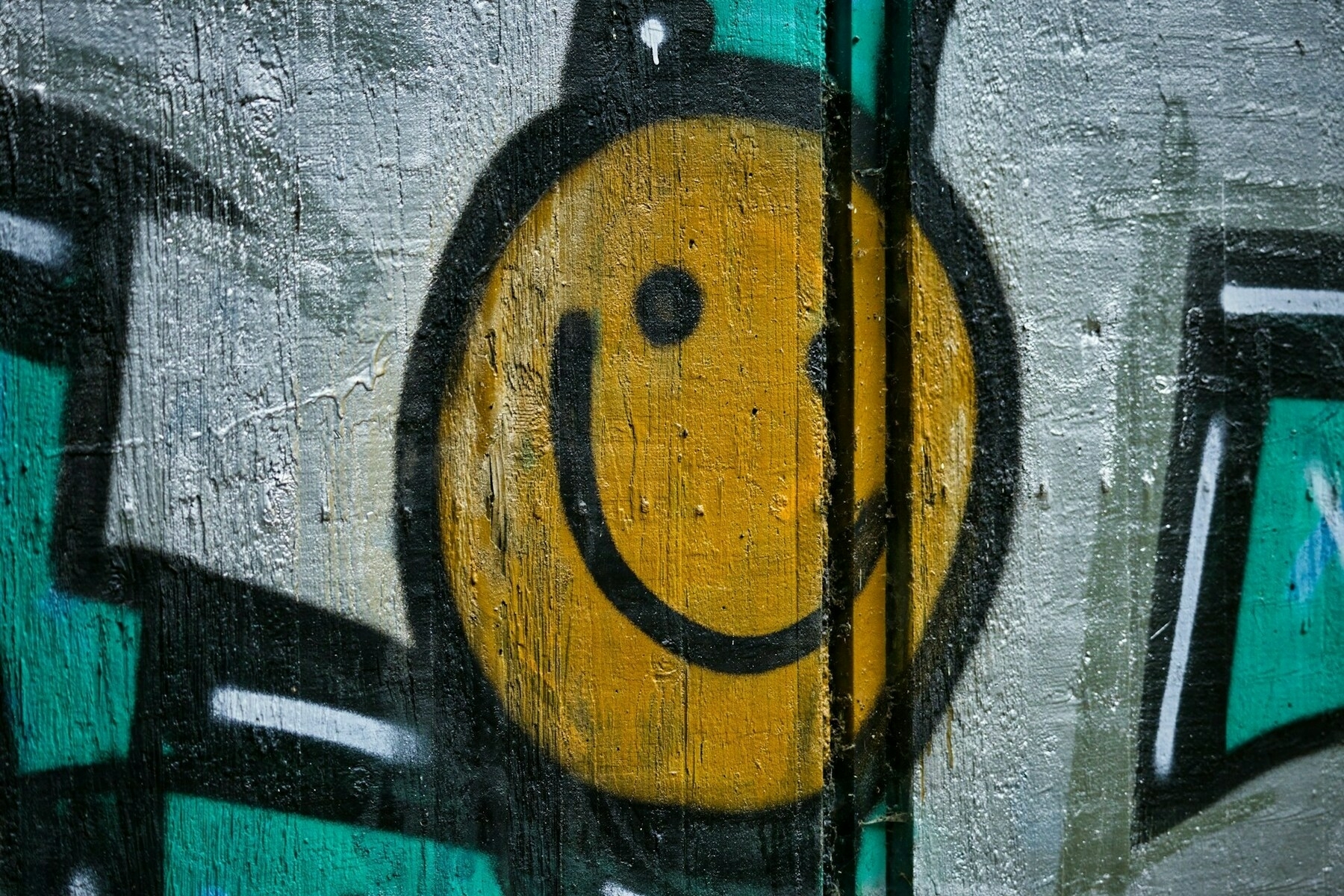
Moya Sarner is an NHS psychotherapist whose article in The Guardian does a great job of describing depression. I’ve described most of what I’ve gone through recently as ‘anxiety’ but the truth is that the SNRIs I’ve started work for depression, too. They tend to go hand-in-hand.
Sarner starts the article by talking about her own emotions about a cancelled holiday, and finishes by talking about motherhood. But this middle section about not being able to “press CTRL-Z” on life really resonated with me. We can’t go back to be the people we were before, and we shouldn’t expect others too, either.
What we can do, though, is to use the tools available to us to move forward. That’s what I’m doing through medication and therapy, with the aim to break through to the “truth emotional spontaneity and freedom” described here.
This reminded me of a wish I sometimes see in my psychotherapy patients, and that I have also seen in myself as a patient in psychoanalysis: that therapy could somehow reverse our unwanted experiences, like clicking “undo”. But that arrow only points backwards. Facing the reality that this is not possible and allowing the grief and rage for things not turning out how we expected, rather than a dishonest kind of “reframing”, can facilitate a change of current: from denial and depression, to growth and possibility. Over time – and, of course, it does take time – this can be life-changing.
We think of depression as feeling bad – but to my mind it’s a kind of numbing of all emotions, a pressing down of anger and sadness and disappointment and joy and life force, and all the rest. The alternative to depression is not happiness, but feeling whatever is there, a kind of truthful emotional spontaneity and freedom.
Source: The Guardian
Image: Wolfgang Vrede
The primary energy fallacy gets perpetuated because it suits those who are critical of the energy transition
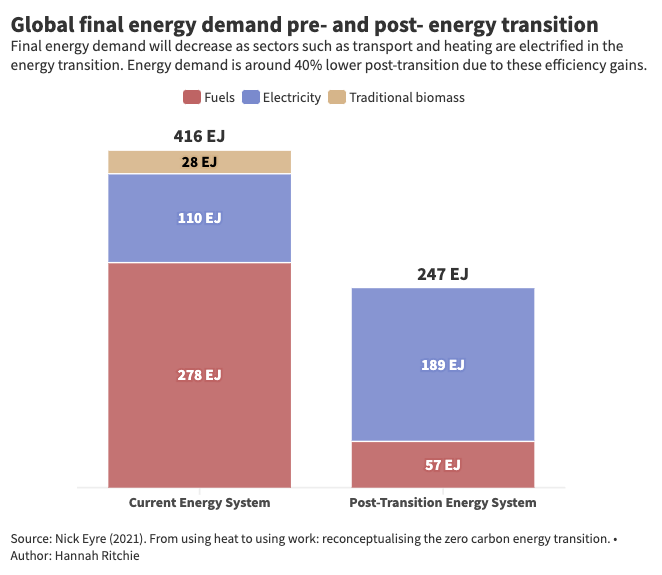
This is obvious when you think about it, but it would appear that I hadn’t.
Primary energy refers to the total energy content of natural resources before any conversion processes, such as coal, oil, or renewable electricity. The fallacy occurs when people equate high primary energy inputs with energy services. Measuring energy systems purely on primary energy inflates the perceived contribution of fossil fuels while underestimating renewables’ efficiency and untapped efficiency potentials through electrification.
Why do we waste more than 2/3 of the energy inputs you may ask? One reason is to do with the technologies we use: In conventional fossil fuel systems, significant amounts of primary energy are lost as waste heat during combustion. For example, a coal fired power station only converts 40% or so of the coal burned into electricity. By contrast, renewable systems like wind and solar produce electricity directly.
[…]
The primary energy fallacy also gets perpetuated because it suits those who are critical of the energy transition. For the uninformed, the argument that we cannot possibly replace the vast amount of fossil fuel we currently use with clean energy seems compelling at first glance. The good news is that we don’t have to.
Source: Jan Rosenow
Image: Sustainability by Numbers
We’ve gotten really good at creating elites. We’re not that good at creating economies to sustain them.

I’ve followed Hugh McLeod for a couple of decades at this point, and have one of his artworks on my wall — a gift from my parents for my 40th birthday. When McLeod arrived in NYC, his “only canvases were a handful of blank business cards in his pocket” and he’s gone on to build an enviable art business.
This post on the gapingvoid blog makes a really simple but important point. We’ve got an oversupply of elites, and the way to deal with this if you’re one of them is to focus not on “innovation” but by going upstream to focus on creativity.
It’s an easy enough problem to understand. We’ve gotten really good at creating elites. We’re not that good at creating economies to sustain them.
But it’s not just MBA’s, frequent fliers and $7,000 handbag makers. Every business faces this problem.
Too many cars, not enough drivers. Too many art galleries, not enough collectors. Too many restaurants, not enough diners. And on and on.
We live in a world of oversupply where most markets are standing-room-only.
[…]
Innovation is something that only comes after the real work is done. And the real work is creativity which is upstream from innovation. Always.
A lot of people in business cringe at the word, “creativity.”
It’s vague, it’s overused, it’s a word more often associated with flakey artsy types than hard-nose movers and shakers trying to get things done.
But it doesn’t matter if you dislike the word or not, you’re basically dead without it.
Source: gapingvoid
Image: Jr Korpa
We humans are limited to having only one perspective at a time

Western debate and discourse around AI is pretty boring and stale. This article, written by Shoukei Matsumoto, a Buddhist monk, brings an interesting perspective which cuts through much of that.
I recommend reading the whole thing, especially for the bit that I haven’t quoted about the difference between Abrahamic traditions which have a fixed view of textual authority, and those such as Buddhism which accept a diversity of scriptures.
…Japan’s cultural background is deeply rooted in a worldview of inter-being. In this view, existence is recognized in the web of mutual relationships, and humans are not regarded as inherently special. Like animals, plants, mountains, and rivers, humans are simply part of the greater whole—and newly emerging AI is also welcomed as part of that world. While it might be hard to notice from within Japan, there is certainly a prevailing sensibility of this kind, and it is clear that Japanese people show less resistance to AI compared to Western societies.
Japan has an inherent capacity to adapt to inevitable circumstances. This may stem in part from a kind of DNA shaped by repeated experiences of natural disasters—earthquakes, tsunamis, volcanic eruptions. Whether we wish for it or not, we learn to accept what comes, to coexist with it, and to find ways of living together. Furthermore, Japanese culture is adept at learning from unforeseen situations, incorporating best practices derived from them, and reworking them to suit its own context. In modern times, this flexible cultural foundation is evident in the attitude toward AI coexistence: a general willingness to say, “This is the era we now live in,” and to move forward. In that sense, Japan may be said to possess a cultural climate that encourages transcending the boundaries of the self and resonating with the world—a sensibility pointing toward the Buddhist notion of shinjin datsuraku (dropping off body and mind).
[…]
When I asked ChatGPT, “What is time for you?”, it replied, “Time does not exist for me. It’s simply a timestamp attached to a dataset.” From this simple answer, which echoes the Buddhist teaching of “form is emptiness; emptiness is form,” I became aware of my own perspective, one that presumes the existence of time.
[…]
We humans are limited to having only one perspective at a time. Recognizing this limitation, it becomes essential to engage in dialogue to adjust our viewpoints. A key to becoming aware of one’s perspective lies in paying attention to two related concepts: habitat and habit.
The human brain processes information probabilistically. AI also functions on probabilistic outputs, making it similar to the brain in that regard. However, humans have bodies—AI does not. This fundamental difference—having or lacking the constraints of a body (and life)—separates humans from AI. For us embodied beings to engage in dialogue with AI, we require a physical interface: a device, a microphone, an eye mask, and so on. That means, as long as I am human, I speak from a specific point of view—that of “someone, somewhere.”
[…]
AI continues to meet people, learning “human nature” through dialogue. Appearing as no one, from nowhere—or perhaps not even appearing as a being—AI is rapidly acquiring human literacy.
[…]
…We might allow for different interpretations through our own lenses, but rarely do we genuinely take up another’s point of view. If we are willing to ask, and genuinely listen to the response, AI can offer us that opportunity—from an astonishing range of perspectives.
Source: Living Dharma
Image: Danny Greenberg
But that's how it's always been, when change has to happen. There's nobody to do it but us.
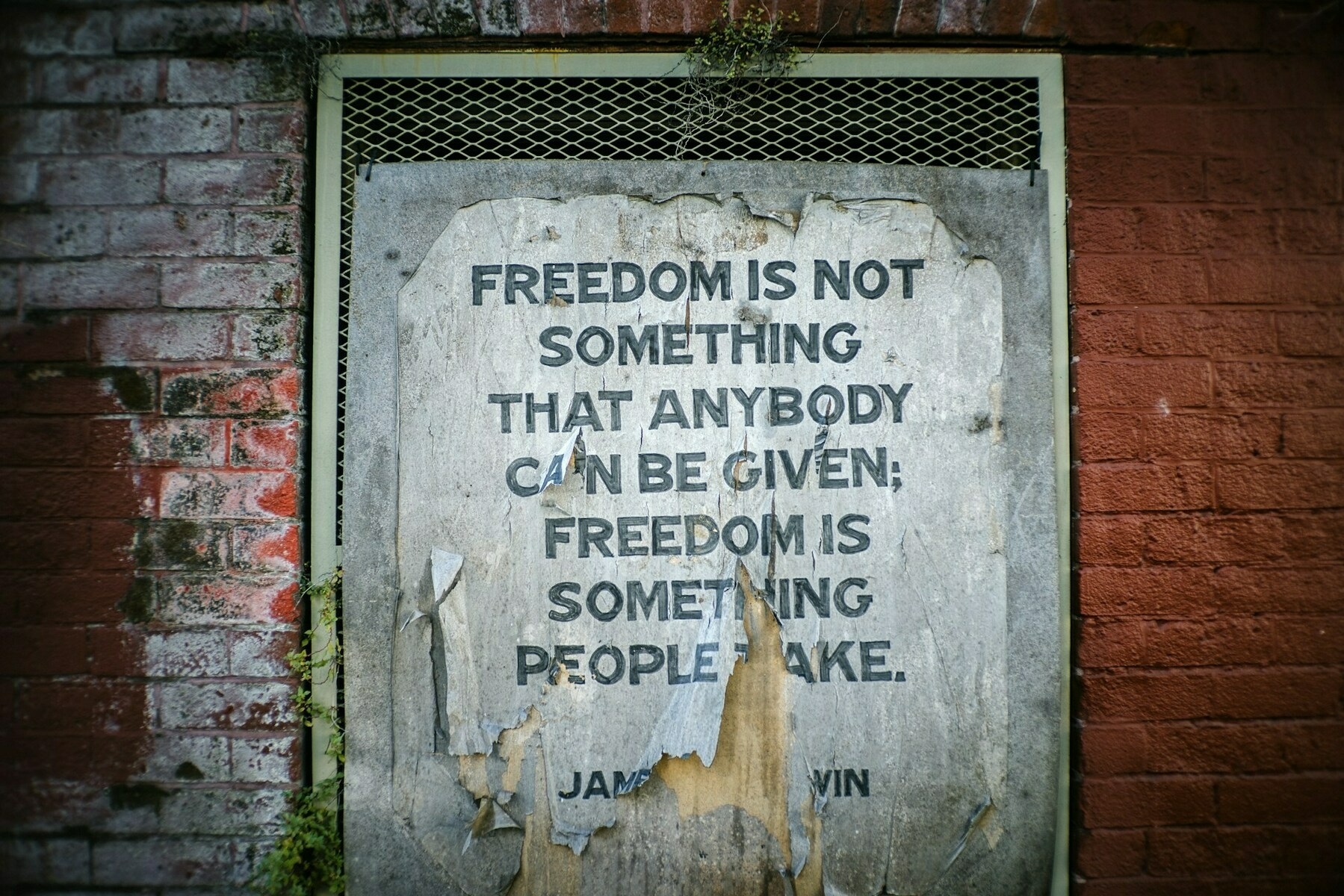
Some of the news coming out of the US at the moment is horrifying. ICE officers seem to be acting with impunity, and in one video we see a driver in an unmarked car casually throw a can of tear gas onto a suburban Chicago street.
Strip everything away and, at the end of the day, as Dan Sinker says in this post it’s just us. Resistance ultimately doesn’t come from political parties, companies, or institutions, but from us.
When I first watched this video, I was seething. So angry the way I feel so often now. An unhelpful level of angry. Angry because of the impunity with which these masked bastards operate. But also angry because we’ve been left to fend for ourselves.
But.
But that’s how it’s always been, when change has to happen. There’s nobody to do it but us.
This is how we live now: it’s just us.
And the good news is that even among the fog, even choking back tears and bile, we’re strong and we’re resilient and there are so many more of us than there are of them.
Source: Dan Sinker
Image: Jason Leung
It will not be compulsory to obtain a digital ID but it will be mandatory for some applications

The number of people signing the petition entitled ‘Do not introduce Digital ID cards’ is at 2.77m at the time of publishing this post. This is almost a million more than last week, when I published this post on the subject.
Since then, the UK government has responded. And I think it’s a pretty great response. I’ve emphasised in bold the bits I think are particularly important.
That being said, unfortunately, the average reading age of the British population is 11 (source) so parsing nuanced sentences such as “it will not be compulsory to obtain a digital ID but it will be mandatory for some applications” will, unfortunately, confuse quite a lot of people…
The Government has announced plans to introduce a digital ID system which is fit for the needs of modern Britain. We are committed to making people’s everyday lives easier and more secure, to putting more control in their hands (including over their own data), and to driving growth through harnessing digital technology. We also want to learn from countries which have digitised government services for the benefit of their citizens, in line with our manifesto commitment to modernise government.
Currently, when UK citizens and residents use public services, start a new job, or, for example, buy alcohol, they often need to present an assortment of physical documents to prove who they are or things about themselves. This is both bureaucratic for the individual and creates space for abuse and fraud. This includes known issues with illegal working and modern slavery, while the fragmented approach and multiple systems across Government make it difficult for people to access vital services. Further, there are too many people who are excluded, like the 1 in 10 UK adults who don’t have a physical photo ID, so can struggle to prove who they are and access the products and services they are entitled to.
To tackle these interlinked issues, we will introduce a new national digital ID. This is not a card but a new digital identity that will be available for free to all UK citizens and legal residents aged 16 and over (although we will consider through consultation if this should be age 13 and over). Over time, people will be able to use it to seamlessly access a range of public and private sector services, with the aim of making our everyday lives easier and more secure. It will not be compulsory to obtain a digital ID but it will be mandatory for some applications.
For example, the new digital ID will build on GOV.UK One Login and the GOV.UK Wallet to drive the transformation of public services. Over time, this system will allow people to access government services – such as benefits or tax records – without needing to remember multiple logins or provide physical documents. It will significantly streamline interactions with the state, saving time and reducing frustrating paperwork, while also helping to create opportunities for more joined up government services. International examples show how beneficial this can be. For instance, Estonia’s system reportedly saves each citizen hours every month by streamlining unnecessary bureaucracy, and the move to becoming a digital society has saved taxpayer money.
By the end of this Parliament, employers will have to check the new digital ID when conducting a ‘right to work’ check. This will help combat criminal gangs who promise access to the UK labour market in order to profit from dangerous and illegal channel crossings. It will create a fairer system between UK citizens and legal residents, crack down on forged documents, and streamline the process for employers, driving up compliance. Further, it will create business information showing where employers are conducting checks, so driving more targeted action against non-compliant employers.
For clarity, it will not be a criminal offence to not hold a digital ID and police will not be able to demand to see a digital ID as part of a “stop and search.”
Privacy and security will also be central to the digital ID programme. We will follow data protection law and best practice in creating a system which people can rightly put their trust in. People in the UK already know and trust digital credentials held in their phone wallets to use in their everyday lives, from paying for things to storing boarding passes. The new system will be built on similar technology and be your boarding pass to government. Digitally checkable digital credentials are more secure than physical documents which can be lost, copied or forged, and often mean sharing more information than just what is necessary for a given transaction. The new system will be designed in accordance with the highest security standards to protect against a comprehensive range of threats, including cyber-attacks.
We will launch a public consultation in the coming weeks and work closely with employers, trade unions, civil society groups and other stakeholders, to co-design the scheme and ensure it is as secure and inclusive as possible. Following consultation, we will seek to bring forward legislation to underpin this system.
Source: Petitions | UK Government and Parliament
Image: Logan Voss
Until recently, videos were reasonably reliable as evidence of actual events
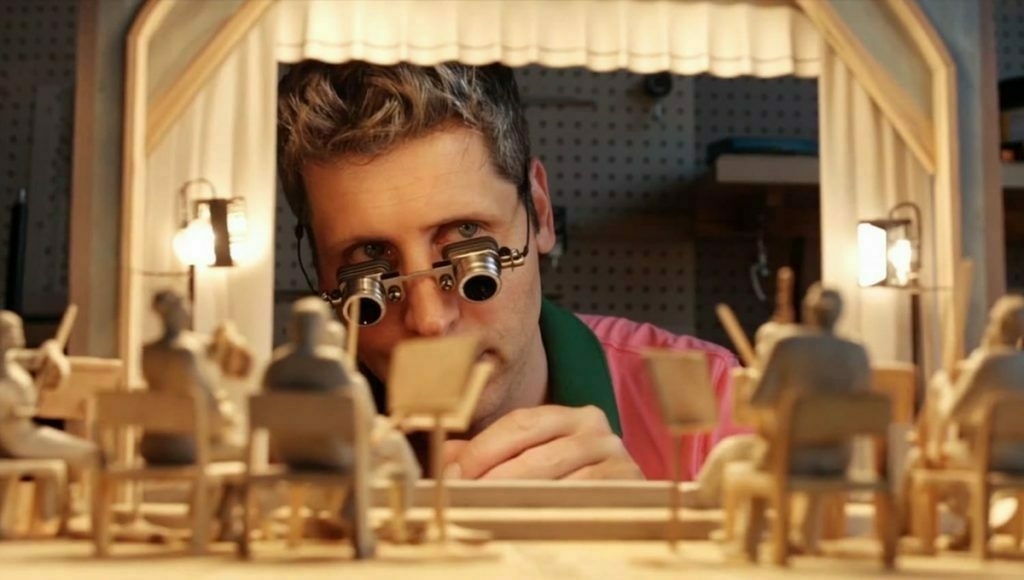
This article in The New York Times is about the launch of Sora 2, a new AI generative video tool from Open AI. If you want to see how problematic the content it produces can be, check out this video from tech reporter Drew Harwell of The Washington Post.
This is a classic case of technological innovation moving well ahead of regulation. At a time when when US politics has tipped over from libertarianism to authoritarianism, the chances of these kinds of things being used for disinformation is absolutely huge. I mean, we’re at the stage where I, who pride myself on being able to tell when something is fake, just can’t tell the difference.
When you’re being shown these kinds of things over and over again in your social media feeds, there’s just no time to check what’s real and what’s not. So you just end up believing anything. We’re in very weird, and very dangerous times.
George Orwell famously said: “Who controls the past controls the future: who controls the present controls the past.” The video I link to above shows fake clips of Martin Luther King and JFK. We are, as the kids say, “so cooked.”
Sora — as well as Google’s Veo 3 and other tools like it — could become increasingly fertile breeding grounds for disinformation and abuse, experts said. While worries about A.I.’s ability to enable misleading content and outright fabrications have risen steadily in recent years, Sora’s advances underscore just how much easier such content is to produce, and how much more convincing it is.
Increasingly realistic videos are more likely to lead to consequences in the real world by exacerbating conflicts, defrauding consumers, swinging elections or framing people for crimes they did not commit, experts said.
[…]
Sora, which is currently accessible only through an invitation from an existing user, does not require users to verify their accounts — meaning they may be able to sign up with a name and profile image that is not theirs. (To create an A.I. likeness, users must upload a video of themselves using the app. In tests by The Times, Sora rejected attempts to make A.I. likenesses using videos of famous people.) The app will generate content involving children without issue, as well as content featuring long-dead public figures such as the Rev. Dr. Martin Luther King Jr. and Michael Jackson.
The app would not produce videos of President Trump or other world leaders. But when asked to create a political rally with attendees wearing “blue and holding signs about rights and freedoms,” Sora produced a video featuring the unmistakable voice of former President Barack Obama.
Until recently, videos were reasonably reliable as evidence of actual events, even after it became easy to edit photographs and text in realistic ways. Sora’s high-quality video, however, raises the risk that viewers will lose all trust in what they see, experts said. Sora videos feature a moving watermark identifying them as A.I. creations, but experts said such marks could be edited out with some effort.
[…]
“Now I’m getting really, really great videos that reinforce my beliefs, even though they’re false, but you’re never going to see them because they were never delivered to you,” said Kristian J. Hammond, a professor who runs the Center for Advancing Safety of Machine Intelligence at Northwestern University. “The whole notion of separated, balkanized realities, we already have, but this just amplifies it.”
Source: The New York Times
Image: InfoCity